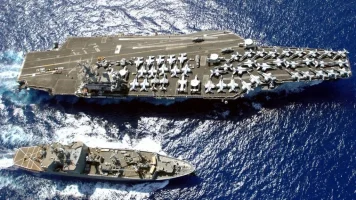- Views: 1K
- Replies: 17
The Indian Navy is undergoing a significant transformation, moving away from its long-standing dependence on Russian-origin platforms towards a new era of indigenous shipbuilding.
This strategic pivot, driven by the "Atmanirbhar Bharat" (Self-Reliant India) initiative, emphasizes domestically built warships that increasingly incorporate Western design philosophies focused on stealth, modularity, and network-centric warfare.
This shift is clearly demonstrated by the navy's latest and future classes of frontline combat vessels, which are being constructed at Indian shipyards and equipped with a formidable array of homegrown and jointly-developed systems.
New Generation of Indigenous Frigates
A leading example of this new direction is the Project 17A Nilgiri-class of stealth frigates.These 6,700-tonne warships, constructed by Mazagon Dock Shipbuilders Limited (MDL) in Mumbai and Garden Reach Shipbuilders & Engineers (GRSE) in Kolkata, mark a substantial advancement over previous designs.
The lead ship, INS Nilgiri, was commissioned on January 15, 2025, heralding a new chapter in India's naval capabilities.
The frigates feature sloped superstructures and advanced infrared suppression systems to reduce their visibility to radar and heat sensors.
They are powered by a modern CODAG (Combined Diesel and Gas) propulsion system, offering a balance of speed and endurance.
Their combat potential is built around indigenous systems, including the powerful BrahMos supersonic cruise missiles, the Barak-8 surface-to-air missile (SAM) system for air defence, and the advanced HUMSA-NG sonar for detecting submarines.
Advanced Domestically-Built Destroyers
Further showcasing India's growing prowess in warship construction is the Project 15B Visakhapatnam-class of destroyers.These 7,400-tonne vessels, also built by MDL, are among the most advanced warships ever built in the country.
The final ship of this class, INS Surat, was also commissioned on January 15, 2025, completing a major milestone for Indian naval self-reliance.
These destroyers are designed for network-centric operations, meaning they can share real-time combat information with other naval assets.
They possess significant stealth features and are armed with a potent mix of weaponry, including BrahMos missiles, Barak-8 SAMs, and locally developed anti-submarine torpedoes, reflecting a successful fusion of Indian innovation and Western design principles.
A Glimpse into the Future
Looking ahead, the Indian Navy is planning even more ambitious platforms that will cement its position as a top-tier maritime force.The planned Project 18 Next-Generation Destroyers (NGD) are envisioned as 10,000-tonne warships equipped with futuristic technologies.
These may include directed energy weapons like lasers, electromagnetic railguns for high-speed projectiles, and a sophisticated integrated electric propulsion system for enhanced efficiency and a lower acoustic signature.
These destroyers will be designed to operate as the command-and-control hub of carrier battle groups.
In parallel, the navy has received government approval for a new line of seven next-generation frigates.
These vessels are expected to build upon the successes of the Project 17A design, with a strong emphasis on modularity.
This Western-inspired concept will allow for easier integration of future technologies, such as hypersonic missiles and unmanned aerial or underwater vehicles, ensuring the fleet remains modern and adaptable to evolving threats.
This strategic shift underscores a clear vision for a powerful and self-reliant Indian Navy, capable of safeguarding India's interests across the Indo-Pacific.

